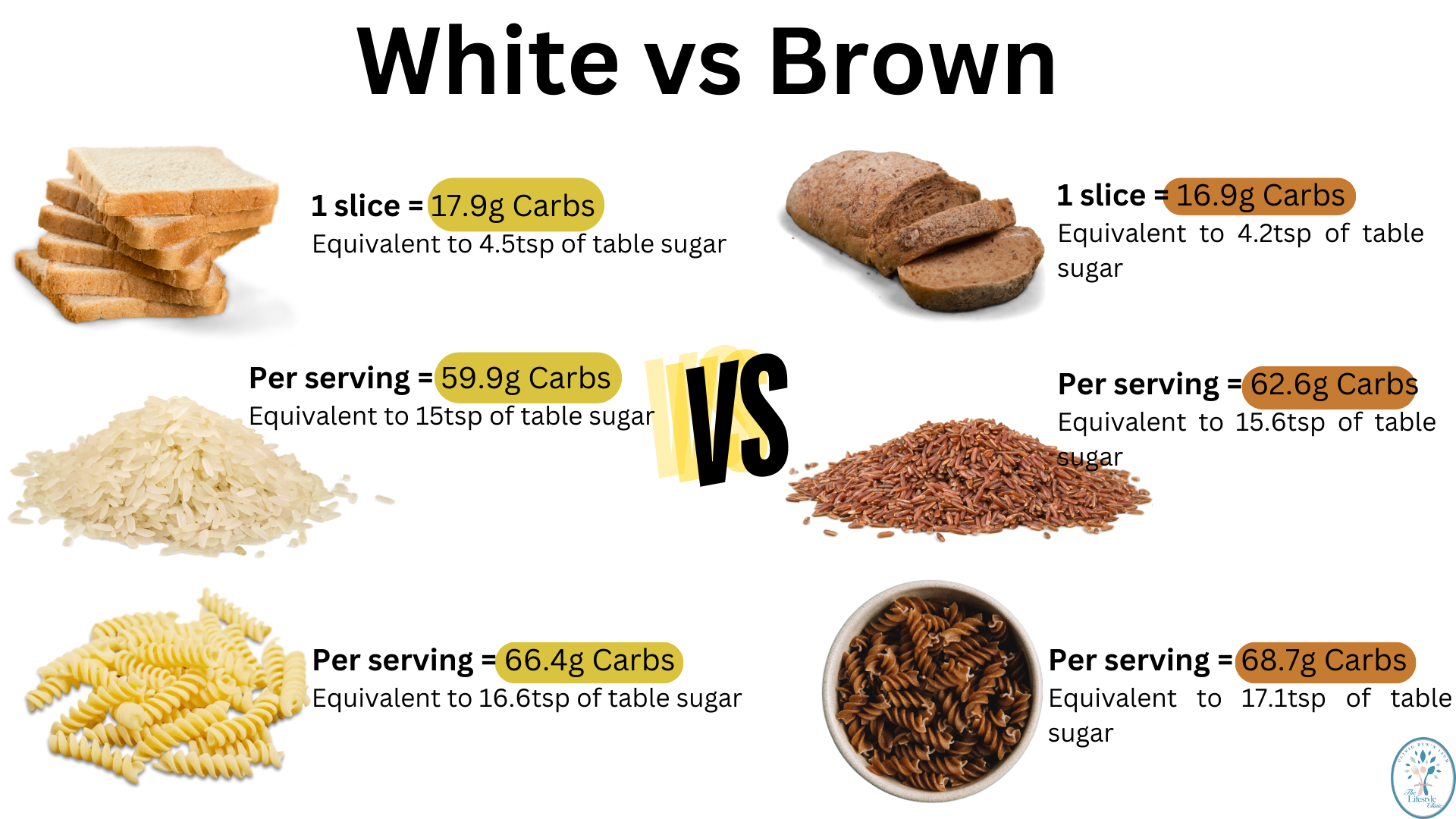
04 Jun How to Reverse Type 2 Diabetes: The Ultimate Guide to Smart Carb Choices and Lifestyle Changes
Can Changing from White to Brown Carbs Make a Difference in Type 2 Diabetes?
One of the most common misconceptions among people with type 2 diabetes is that simply switching from white rice, bread, or pasta to their “brown” versions will automatically improve blood sugar control. Last Friday in my GP clinic, a patient with type 2 diabetes came in, frustrated that his HbA1c had increased by 10 mmol/mol in six months despite following a low-carb diet. He had even switched to brown rice and brown pasta, yet his blood sugars were still rising.
This scenario is incredibly common. Many people believe that “brown” equals healthy, but when it comes to type 2 diabetes, the effect of food on blood sugar is far more complex than the colour of your carbs.
Why Brown Rice or Pasta Isn’t Always Better for Blood Sugar
When managing type 2 diabetes, it’s essential to understand that fibre content alone doesn’t guarantee stable blood sugar levels. Brown rice and pasta may have more fibre than white versions, but they often still contain a similar amount of digestible carbohydrates, which are the primary drivers of blood sugar spikes.
For someone with type 2 diabetes, every carbohydrate consumed is essentially a sugar load that the pancreas must process. If the pancreas is struggling due to insulin resistance, even “healthy” carbs can worsen blood sugar control.
What Happens to Your Body When You Eat Carbs with Type 2 Diabetes?
Carbohydrates break down into glucose, the main sugar in your blood. In people with type 2 diabetes:
- The pancreas produces insulin, but the body’s cells are resistant to it.
- Glucose remains in the bloodstream longer, causing higher blood sugar levels.
- Over time, elevated blood sugar can lead to complications such as neuropathy, kidney disease, and cardiovascular problems.
Even small spikes matter. Choosing the right type of carbs and managing portion sizes can help reduce these spikes and give your pancreas a break.
How Can You Identify Carbs That Are Safe for Type 2 Diabetes?
Not all carbs are created equal. Here’s a simple way to evaluate whether a carb is helping or hurting your blood sugar:
- Check the nutrition label for total carbohydrate content per serving.
- Look at the fibre content; higher fibre can slow glucose absorption.
- Consider glycemic index (GI) values, but remember GI alone doesn’t always reflect the impact of a food when combined in a meal.
- Opt for minimally processed, low-carb vegetables and legumes as your primary carbohydrate sources.
By doing this, you can make informed swaps that truly support blood sugar management.

What Are the Best Food Swaps for People with Type 2 Diabetes?
Instead of relying on brown rice or pasta, try these carb alternatives that are proven to stabilize blood sugar:
- Cauliflower rice or spiralized vegetables instead of rice or pasta
- Legumes such as lentils, chickpeas, and black beans as a low-GI carb option
- High-fibre vegetables like broccoli, spinach, zucchini, and peppers
- Quinoa and buckwheat in small portions if grains are desired
These swaps not only reduce blood sugar spikes but also help with weight management and long-term metabolic health.
How Does Weight Management Help Reverse Type 2 Diabetes?
Weight loss plays a crucial role in improving insulin sensitivity. Even a modest reduction of 5–10% of your body weight can:
- Lower blood sugar levels
- Improve cholesterol and blood pressure
- Reduce inflammation in the body
- Support long-term reversal of type 2 diabetes
Weight management is not just about aesthetics—it’s a medical strategy to restore normal blood sugar function.
Can Lifestyle Changes Really Reverse Type 2 Diabetes?
Yes! Evidence shows that with the right dietary changes, regular physical activity, and weight management, many people can significantly reduce or even normalize blood sugar levels. Some patients achieve remission by:
- Adopting a low-carb or moderate-carb, whole-food diet
- Increasing daily physical activity (walking, resistance training, aerobic exercise)
- Monitoring blood sugar and adjusting diet as needed
- Reducing stress and improving sleep quality
Reversing type 2 diabetes isn’t about a single “magic pill”—it’s about sustainable, long-term habits that restore metabolic health.
What Tools Can Help You Stay on Track?
I’ve created a free visual guide to help you make the right food swaps. Print it, put it on your fridge, and use it as a daily reminder of which choices support blood sugar control.
Additionally, you can download “The Big 5 & Substitutions” guide here — a simple, practical resource that outlines five key food categories to rethink and the best swaps to lower blood sugar naturally.
And if you’d like to go deeper, my three-part breakthrough video series provides step-by-step strategies, meal ideas, and lifestyle tools to help you reverse type 2 diabetes effectively.
How Quickly Can You See Results?
Some changes can have an immediate impact on blood sugar, but long-term lifestyle adjustments are necessary for lasting results. By combining dietary swaps with physical activity and weight management, many patients notice:
- Lower post-meal glucose readings within days to weeks
- Improved energy levels
- Gradual reduction in HbA1c over months
Remember, the cumulative benefits over 5–10 years are far greater than short-term fixes.
What Are the Common Mistakes People Make When Trying to Reverse Type 2 Diabetes?
Here are some pitfalls to avoid:
- Relying solely on “brown” or “whole grain” versions of high-carb foods
- Ignoring portion sizes
- Neglecting physical activity
- Failing to monitor blood sugar regularly
- Trying quick fixes instead of sustainable changes
Avoiding these mistakes makes your efforts far more effective and sustainable.
Why Acting Today Matters
Every step you take now—adjusting carb intake, exercising regularly, improving sleep, and reducing stress—creates a ripple effect for your long-term health. Small, consistent changes are more impactful than drastic, short-term diets.
Preventing the complications of type 2 diabetes—such as heart disease, neuropathy, and kidney problems—starts with informed daily choices. By acting now, you set yourself up for a healthier, more independent future.
Key Takeaways to Reverse Type 2 Diabetes
- Brown rice or pasta is not automatically better than white for blood sugar control.
- Focus on low-carb, high-fibre alternatives like vegetables, legumes, and cauliflower rice.
- Combine diet, exercise, and weight management for best results.
- Use visual guides and resources to stay on track, including the blood sugar guide and breakthrough video series.
